Introduction, Specifications and Pricing
Micron's first enterprise NVMe SSD, the 9100 Series, reach full capacity at 3.84TB. Micron's sophomore release increased capacity to 11TB but the read and write performance was imbalanced, like most enterprise SSDs still shipping today. Today we will look at Micron's third generation enterprise SSD series with increased capacity and a balanced approach to performance that enables consistent performance for all workloads.
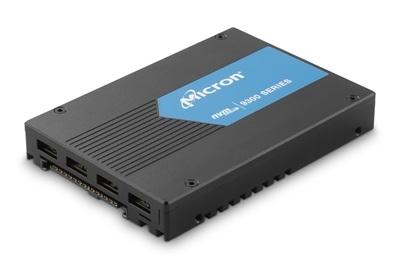
The 9300 Series isn't just about reaching new performance heights. Micron added new tricks to the series. System administrators can expect more than a 28% improvement in power efficiency, larger sizes to reduce rack/floor space, and 32 NVMe namespaces so you can maximize the drives with parallel sessions.
The best part is the robust deliver that Micron implemented with the 9300 Series. It breaks down into two performance tiers and six capacities so you don't have to pay for more than you need.
Specifications
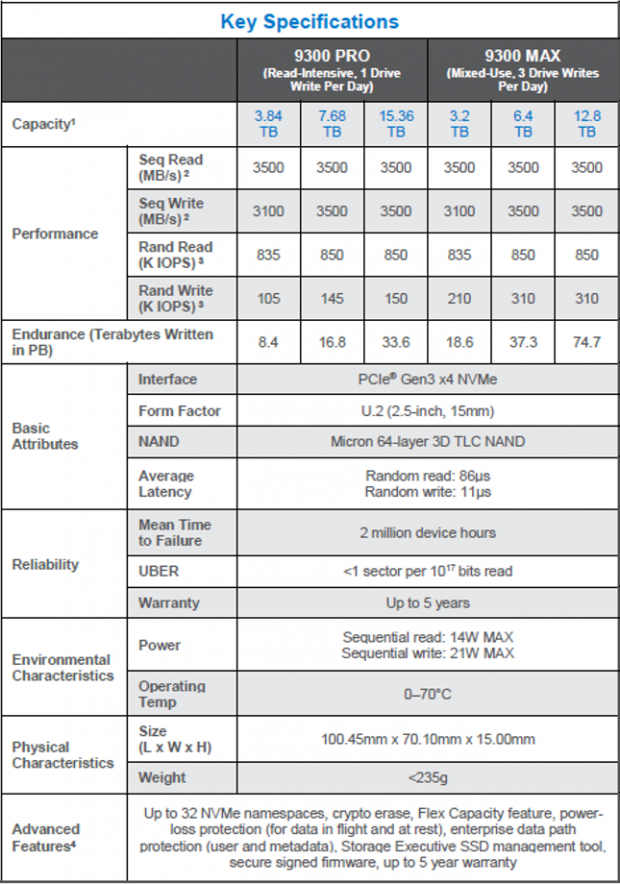
As mentioned, the 9300 Series breaks into two groups, the PRO models for more restrained enterprise workloads and the MAX models for stressful write-intensive workloads. Our testing today will show the differences between the two in a number of workloads so you can easily see where the two stand.
Undoubtedly, there will be some references to the closely related Memblaze PBlaze5 916. Micron offers a high capacity tier that Memblaze doesn't. We also expect to see some differences in firmware as well as pricing in the different markets.
Looking at the capacity first, there are really only three main starting points that break down into six user addressable sizes. The 9300 MAX reserves more flash for background activities that provide increased performance for data written as well as increased endurance. The 9300 PRO models give some of that reserved capacity back but still reserves enough space to keep the 64-layer 3D TLC memory happy. If your application requires more overprovisioning, you can use the Flex Capacity feature in Storage Executive to fine tune the drives.
Pricing, Warranty, and Endurance
We don't have pricing details at this time, but the Micron 9300 Series is currently in mass production. The series comes with a 5-year warranty and ample endurance measured in the petabyte range. The chart above lists the endurance by model with the highest coming in at 74.7 petabytes.
Accessories and Software
The Micron 9300 Series supports Micron's Storage Executive software with both Windows and Linux versions available.
A Closer Look
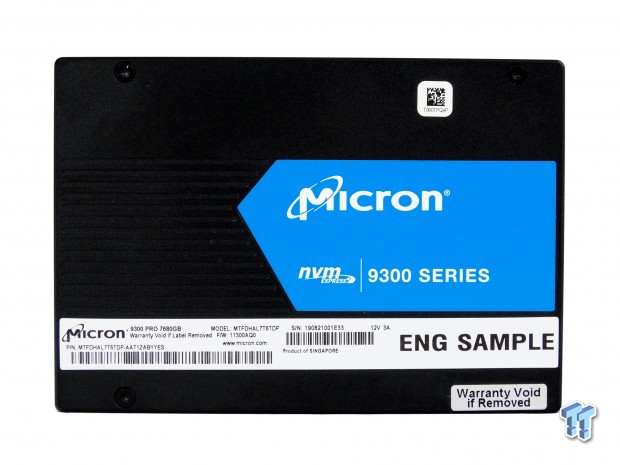
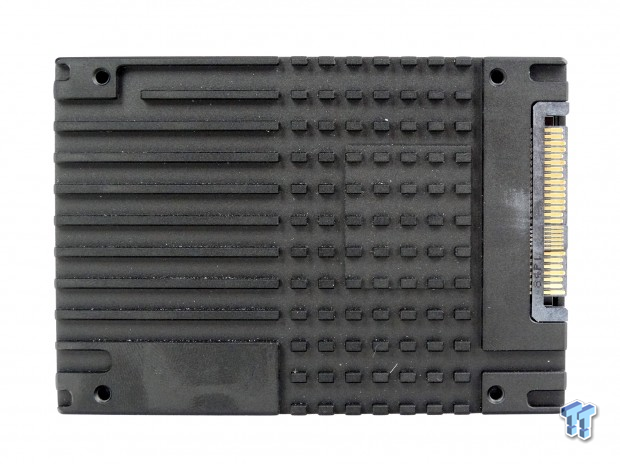
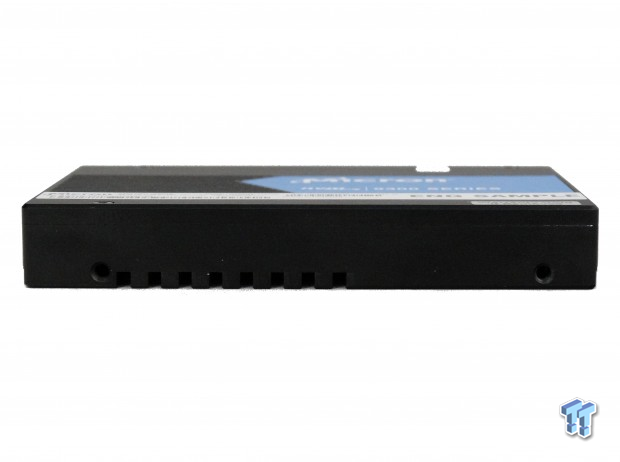
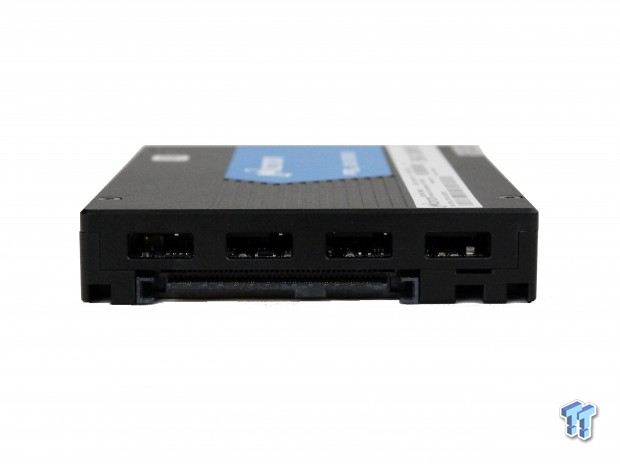
Both the 9300 PRO and 9300 MAX SSDs appear identical other than a slight change to the product label. We have a 9300 PRO sample from Micron and use it to test the performance of both the PRO and MAX by changing the overprovisioning by shrinking the user-exposed volume.
The series only ships in a 15mm z-height form factor.

Synthetic Performance Testing
Product Comparison
For testing, we configured the 9300 Series in both PRO (7.68TB) and MAX (6.4TB) configurations. We also included the Intel DC P4510 8TB, Memblaze PBlaze 5 916 6.4TB, and finally a Micron 9100 2.4TB drive in the comparison pool.
Sequential Read Performance
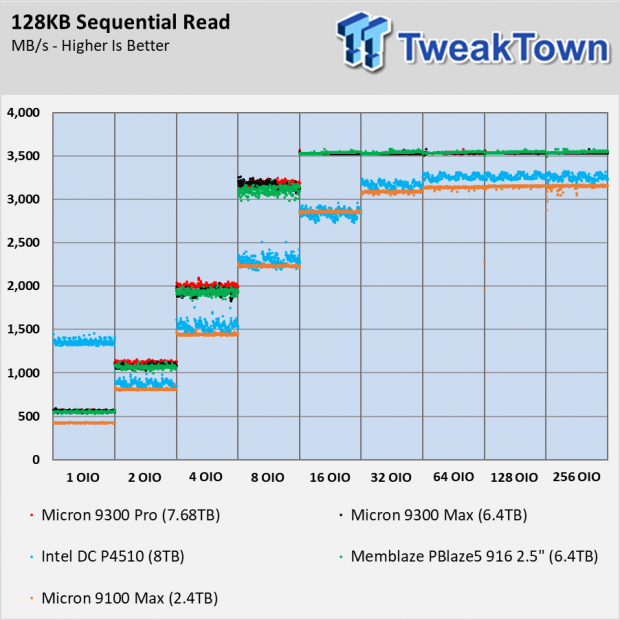
Reading 128KB sequential data from the 9300 Series shows nearly identical performance between the PRO and MAX configurations. The Micron drives outperform most of the others at low queue depths with the Intel being the expectation at QD1. The Memblaze PBlaze 5 916 with nearly identical hardware to the 9300 Series walks up the queue depth latter with similar performance, as you might expect.
Sequential Write Performance
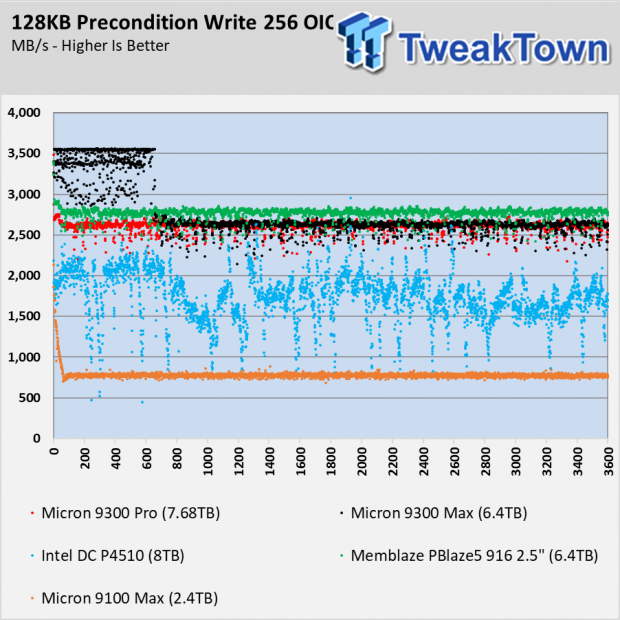
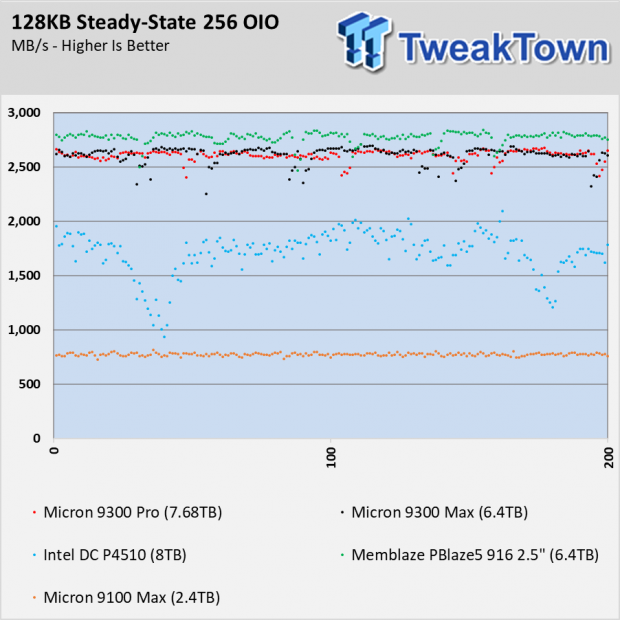
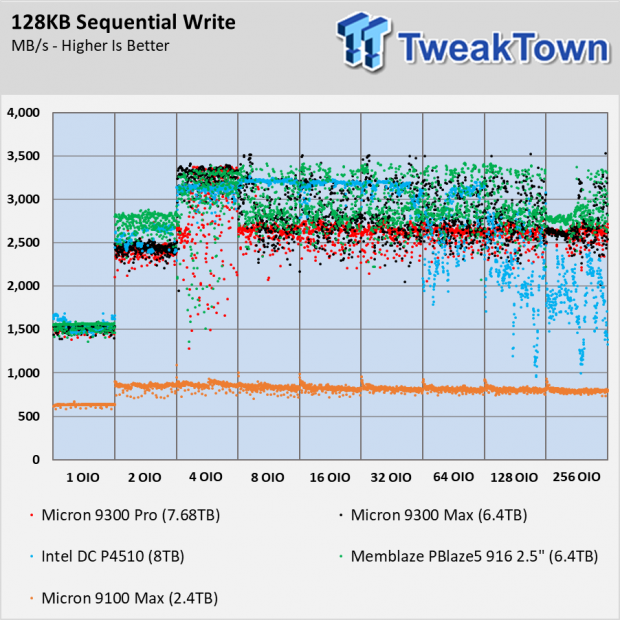
The sequential write performance is also very similar with both 9300 Series configurations. The write performance is very close to what we saw in the sequential read chart and shows that Micron is very close to balanced performance for workloads requiring equal IO.
We haven't talked much about the first generation Micron NVMe SSD, the 9100 MAX. We included this drive to show how far Micron has advanced the series in just three generations.
Sequential Mixed Workload Performance
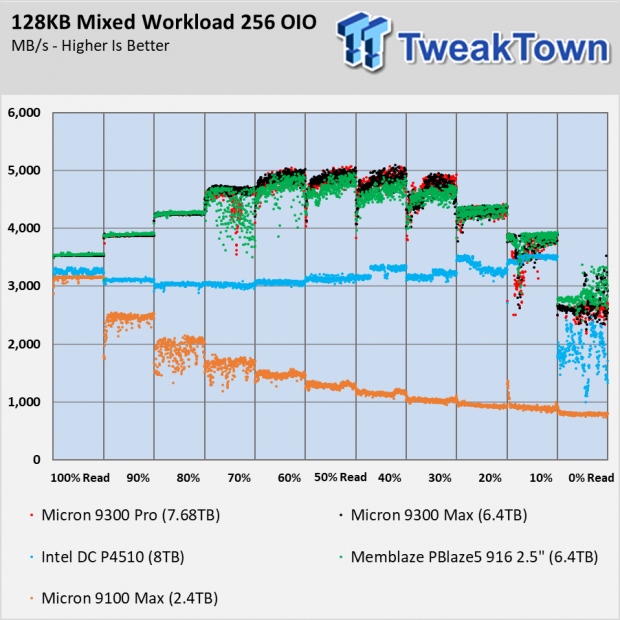
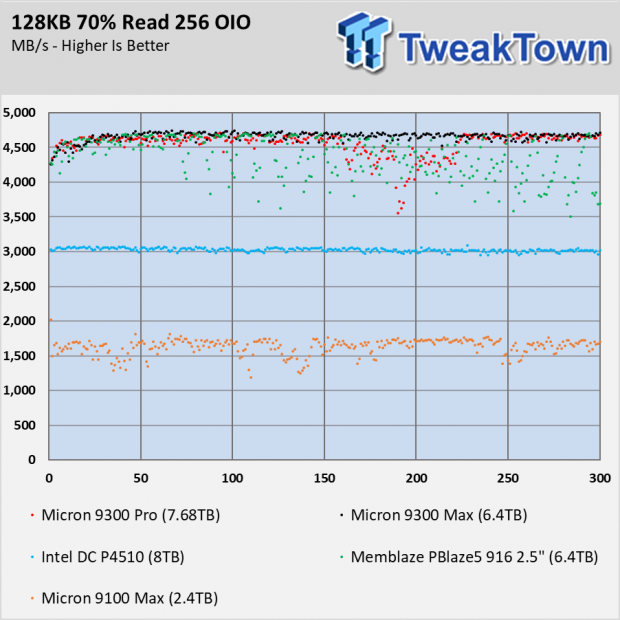
The equal IO between reads and writes helps the 9300 Series achieve very impressive sequential mixed workload performance.
The 70% read mix allows us to look closer at the consistency of the IO. This is where the MAX configuration with more overprovisioning stands above the PRO. For most of the sequential 70% read workload, both configurations follow a rail of performance, but between 150 and 200 seconds, you can see the PRO flutter slightly where the MAX doesn't waver.
Random Read Performance
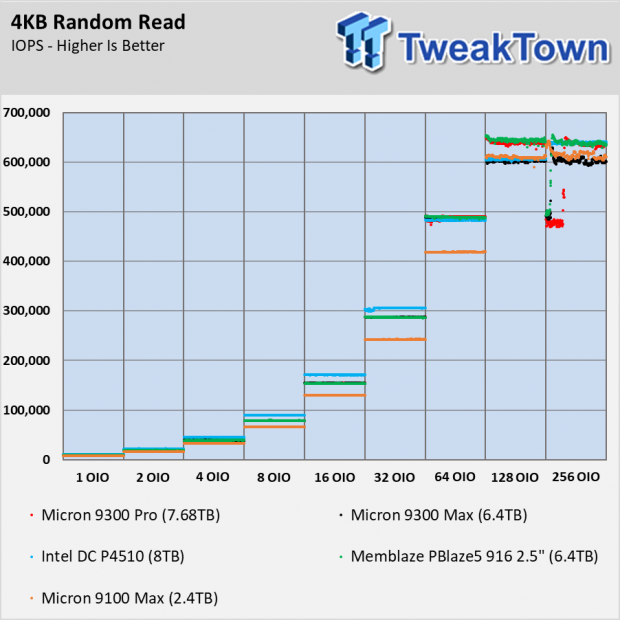
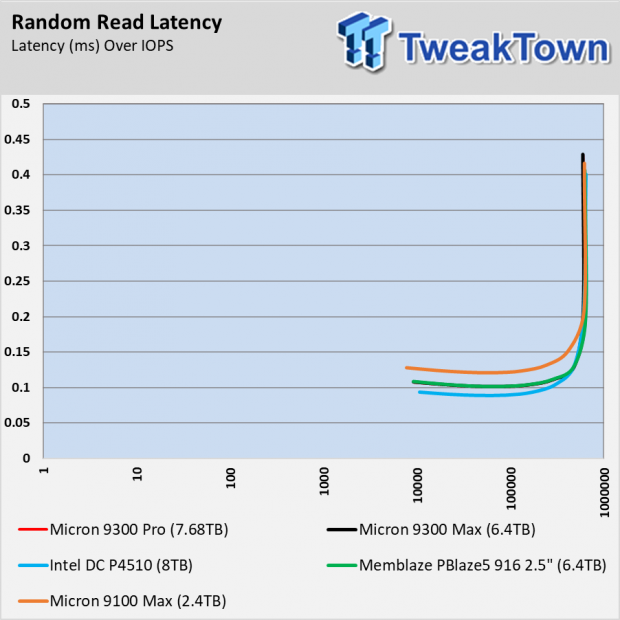
At lower queue depths, the PRO configuration holds steady, but we see more variation at high queue depths. The 9300 MAX also had a little issue at 256 OIO, as did the PBlaze 5 916. The 9300 Series is at the top of the performance chart though at high queue depths.
I want to point out that we did not meet Micron's 850,000 IOPS rating for random reads. This test system has never produced results higher than what we tested with the Micron 9300 Series at high outstanding IO (OIO). The series even outperformed the Intel Optane SSD DC P4800X and Samsung 983 ZET (Z-NAND SSD) at 256 OIO.
Random Write Performance
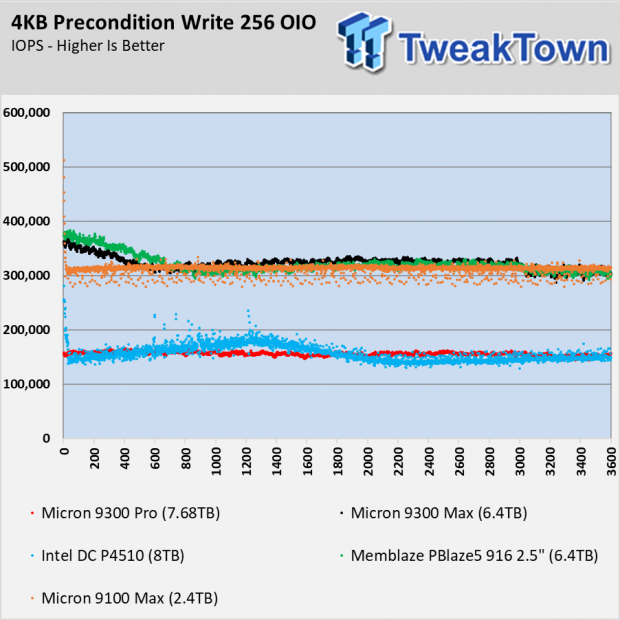
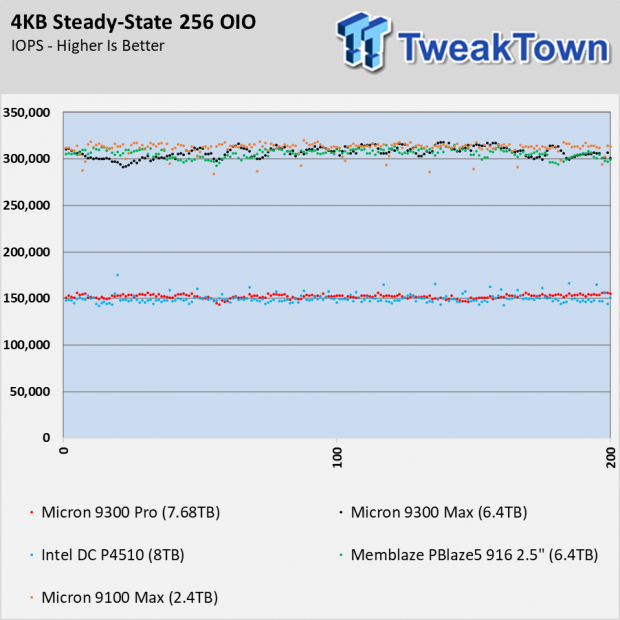
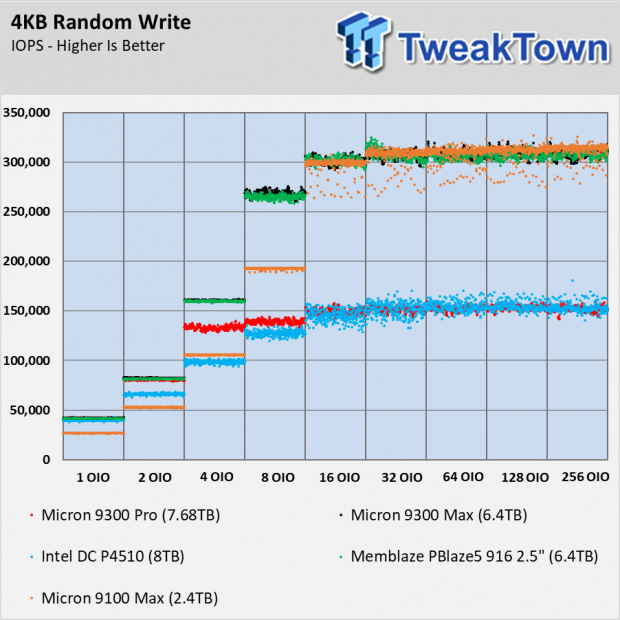
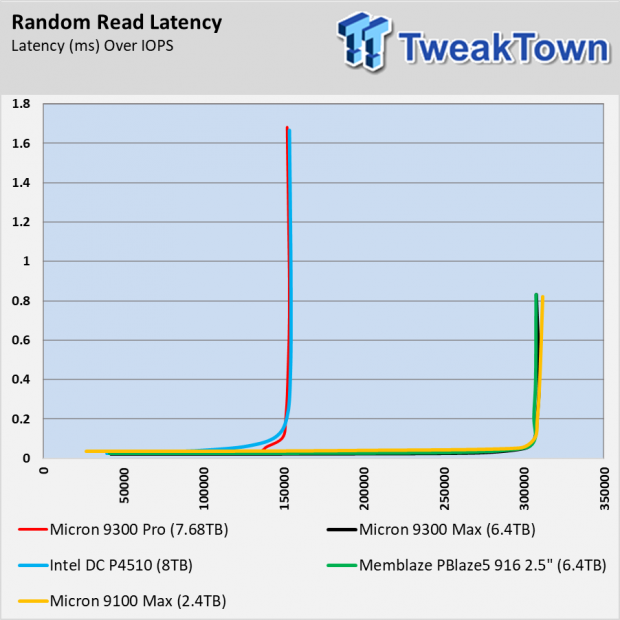
The random write test shows us the first significant performance separation between the Micron 9300 PRO and MAX configurations. This is where the extra flash in reserve aids in both performance and consistency.
In steady state at 256 OIO, all of the drives separate into two distinct performance classes. The separation starts early in the OIO scale with the MAX and PRO diverging at 4 OIO.
Random Mixed Workload Performance
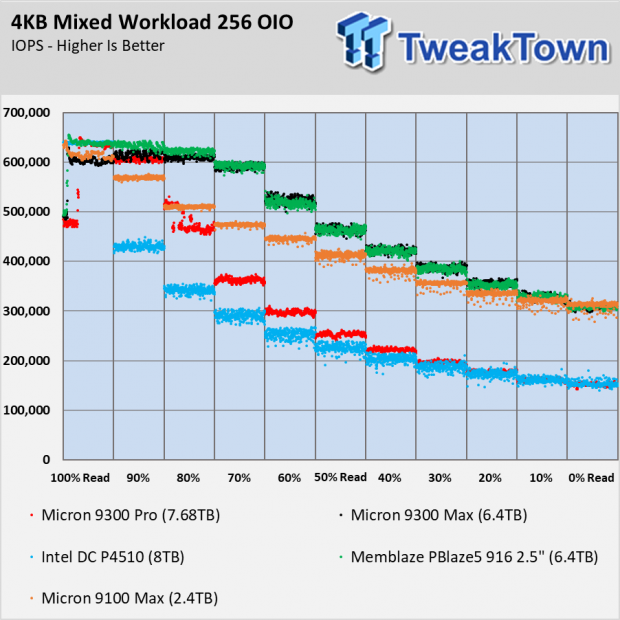
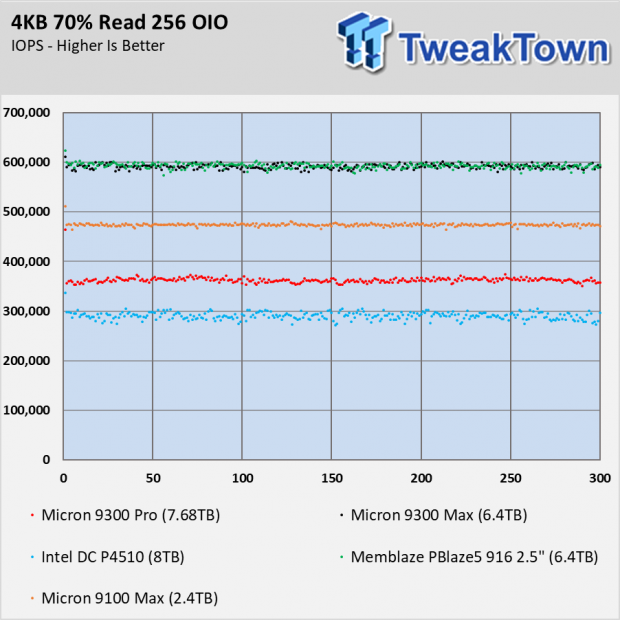
The Micron 9300 Series doesn't provide equal IO performance for random small block data like it does large block sequential data. Both drives in the series do provide excellent random mixed workload performance.
Workload Performance Testing
With the move to server workloads, we should see more differences between the 9300 PRO and MAX configurations.
Database Workload
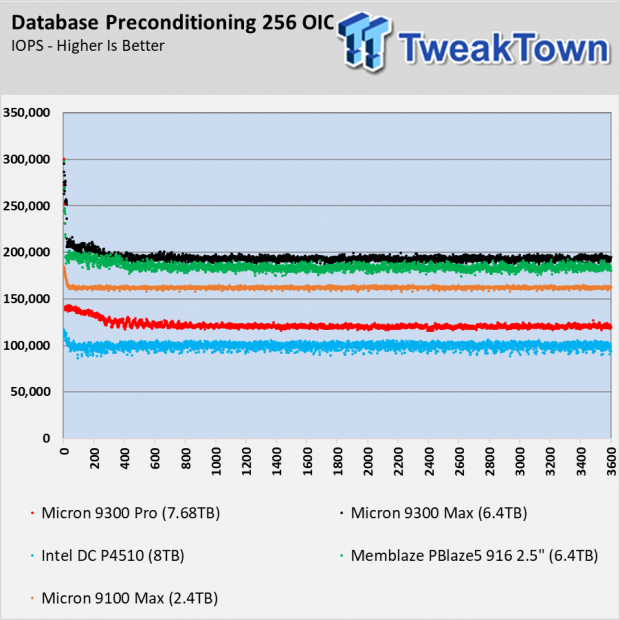
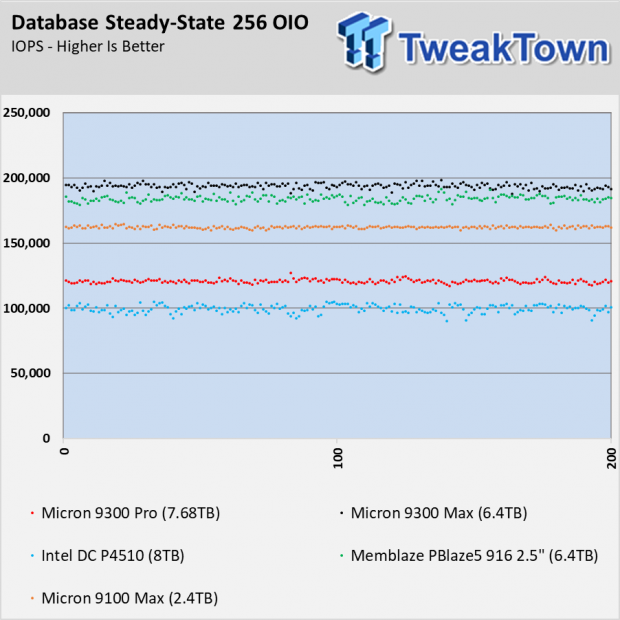
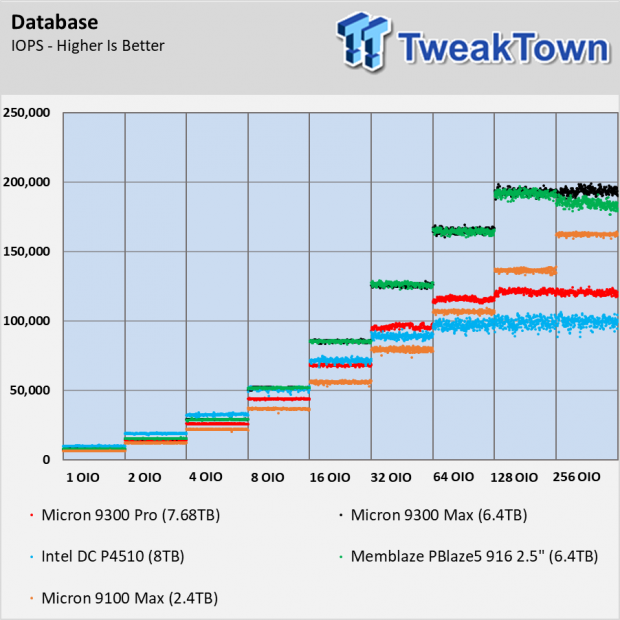
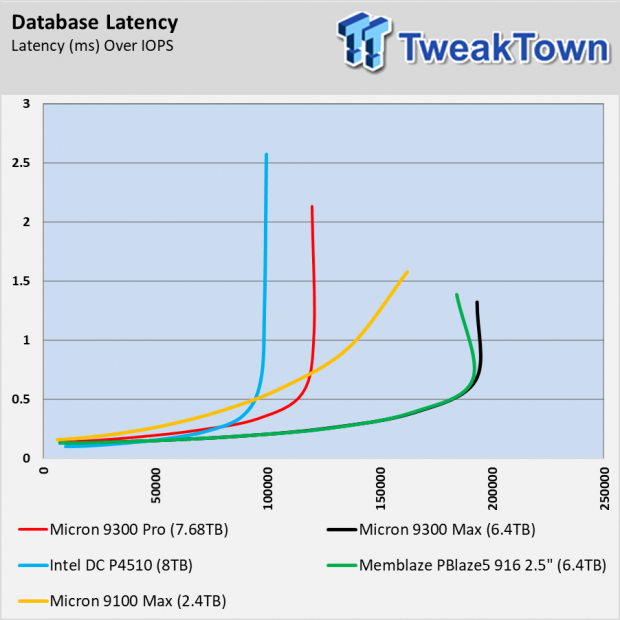
In the database test, the 9300 MAX and Memblaze PBlaze5 916 shoot the performance up to an isolated island of IOPS with the 9100 MAX not far behind. Going into this review, we hoped Micron could leverage the advantages of 64L NAND to outperform the 9100 MAX with the 9300 PRO but the technology didn't get us there at high OIO, but it does deliver more IOPS up to 64 OIO. The new enterprise drive in the MAX configuration does increase performance considerably with database workloads. Both 9300 Series configurations put a boot to the throat to Intel's DC P4510.
OLTP Workload
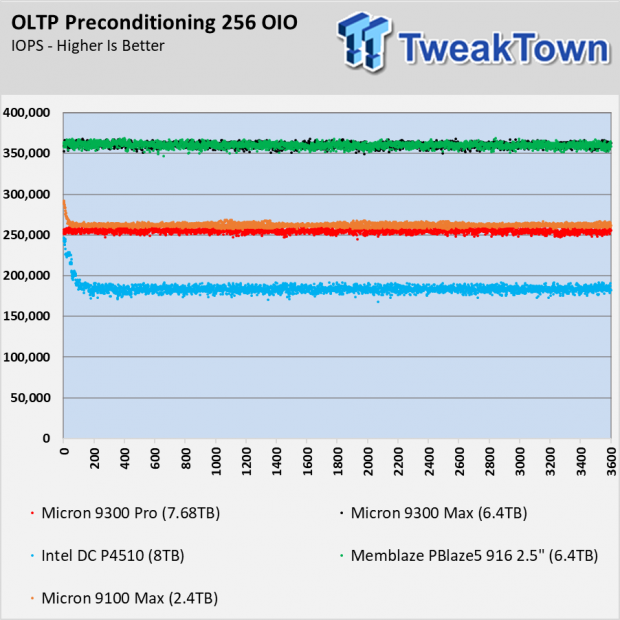
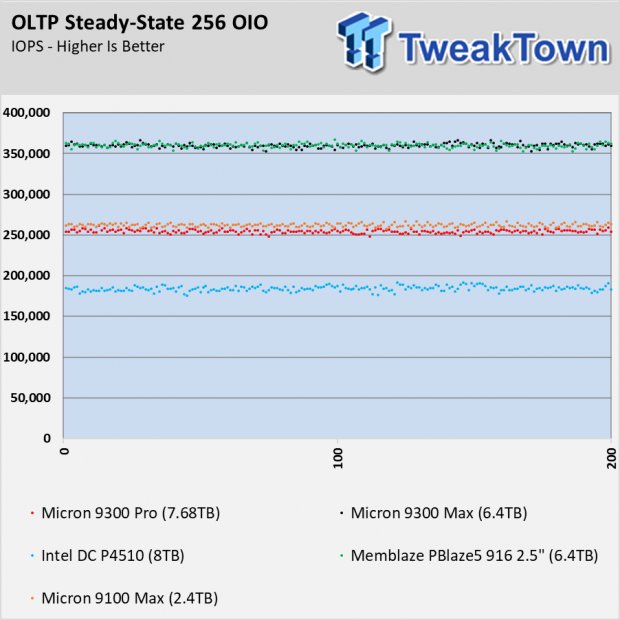
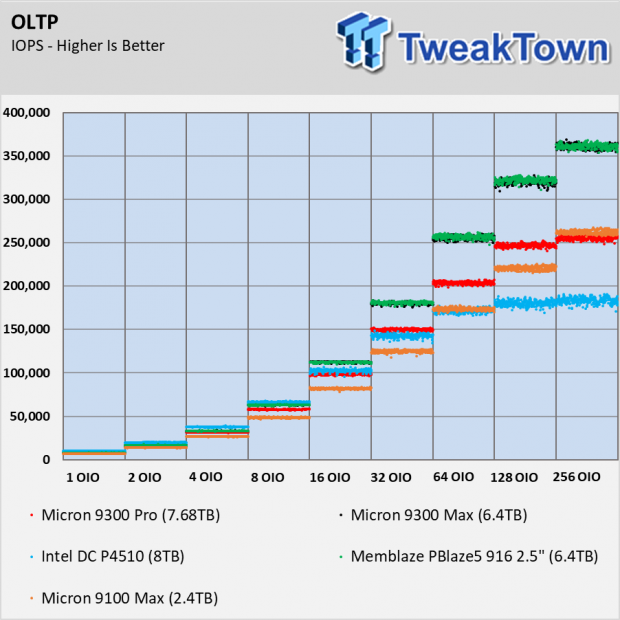
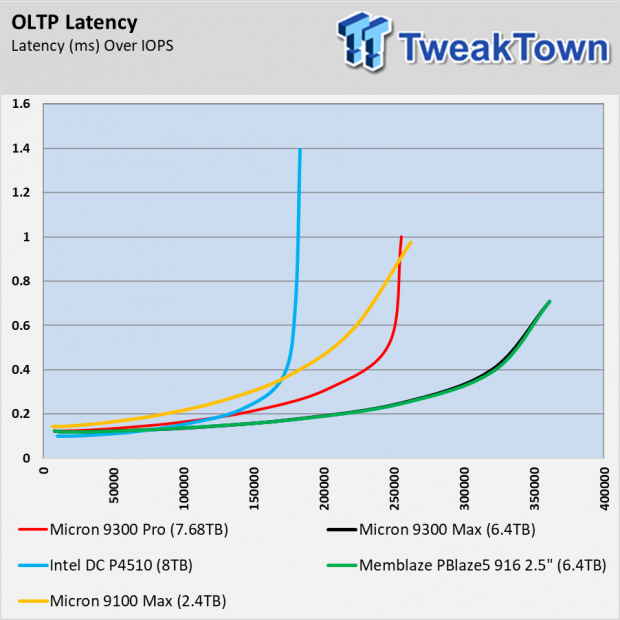
In the OLTP test, the 9300 PRO configured with 7.68TB of user addressable storage does outperform the older 9100 MAX to 256 OIO. The 9300 MAX again proves to be the superior performer putting a great distance on the 9100 MAX, as well as most of the other drives in this test.
Email Workload
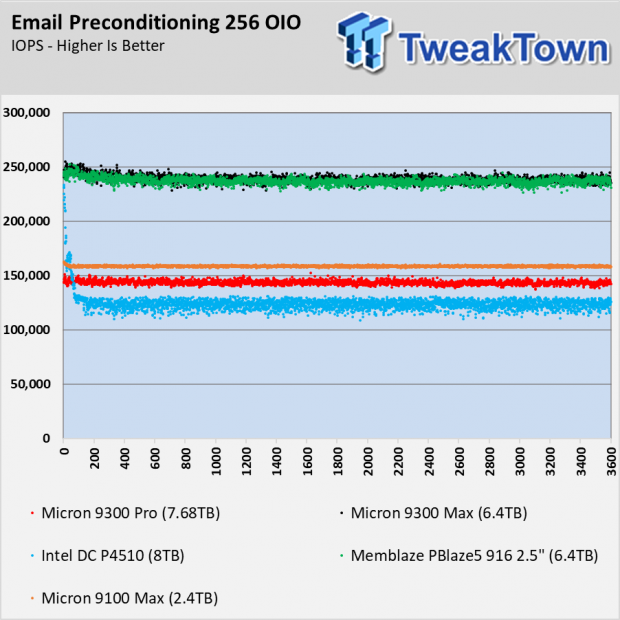
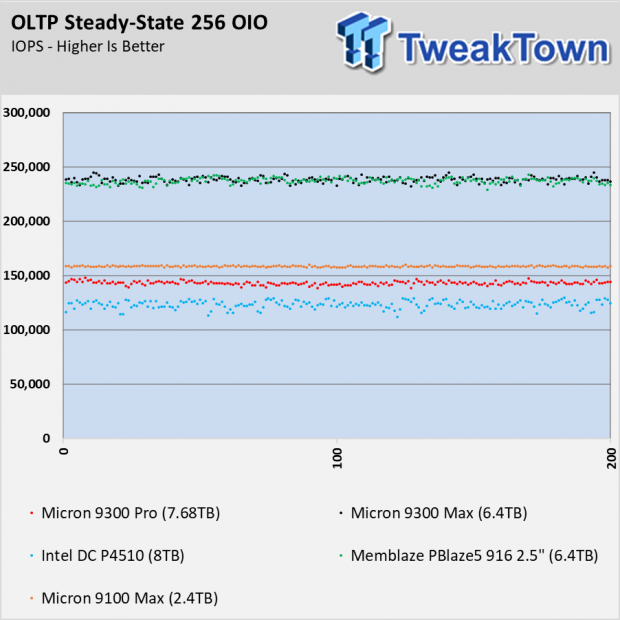
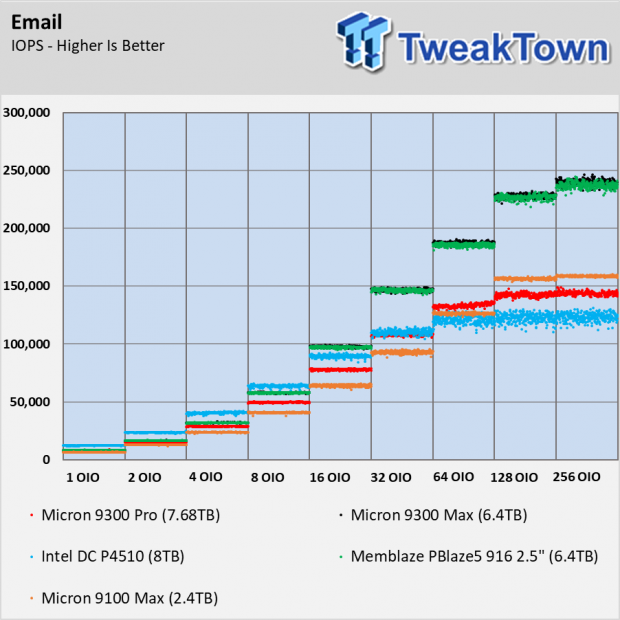
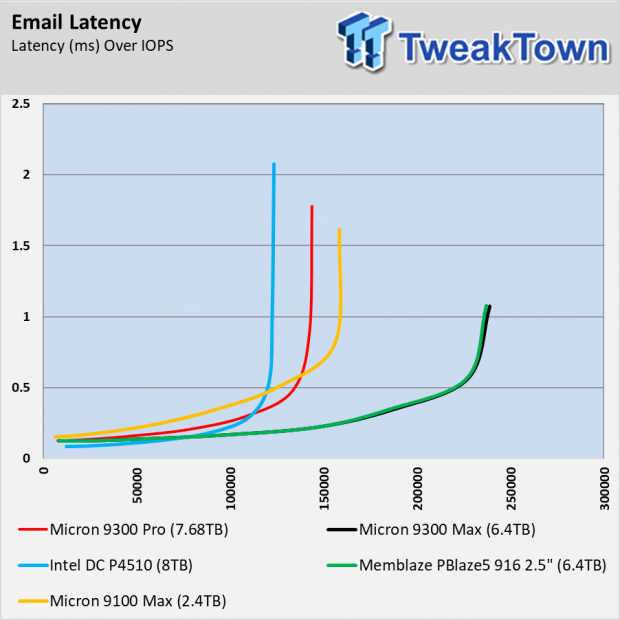
The email workload gives us an opportunity to touch on the 9300 PRO's leveling off when pushed with extreme IO. The performance doesn't improve much in this, and some of the other tests, after 64 OIO. Here we see 64, 128 and 256 OIO performance all within a small range. The increased overprovisioning of the 9300 MAX allows that series to climb higher when required.
Archive Workload
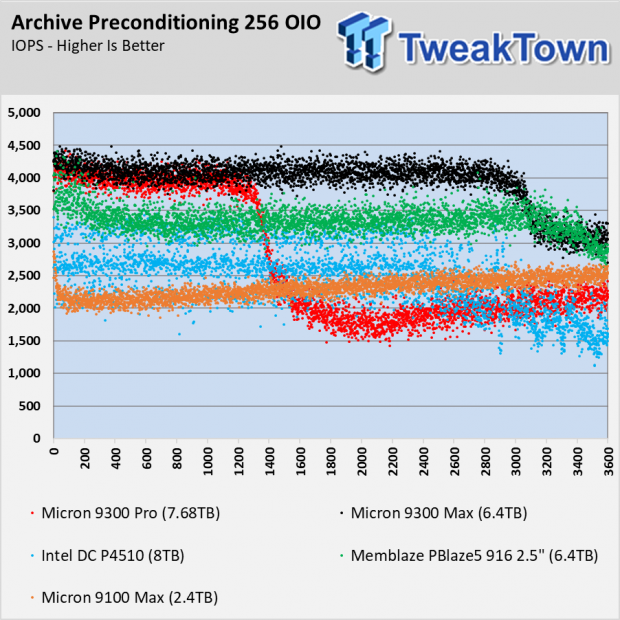
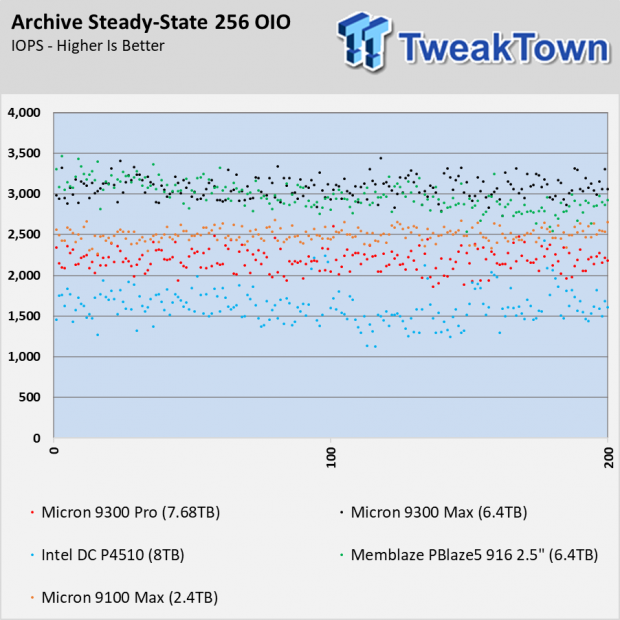
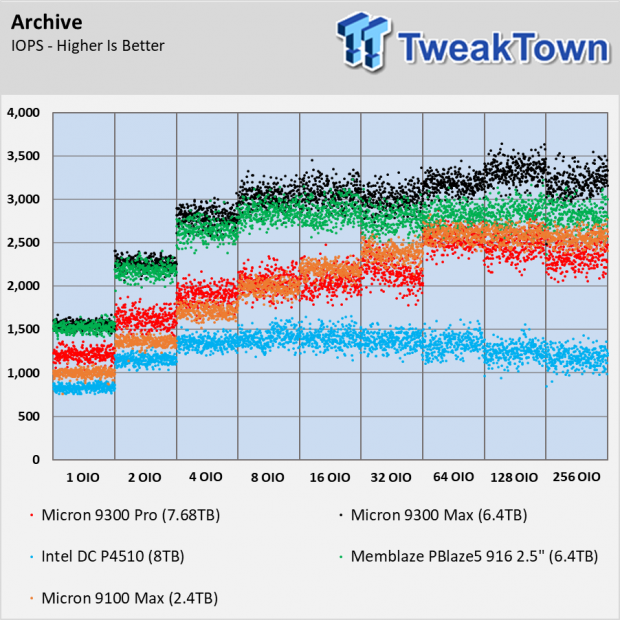
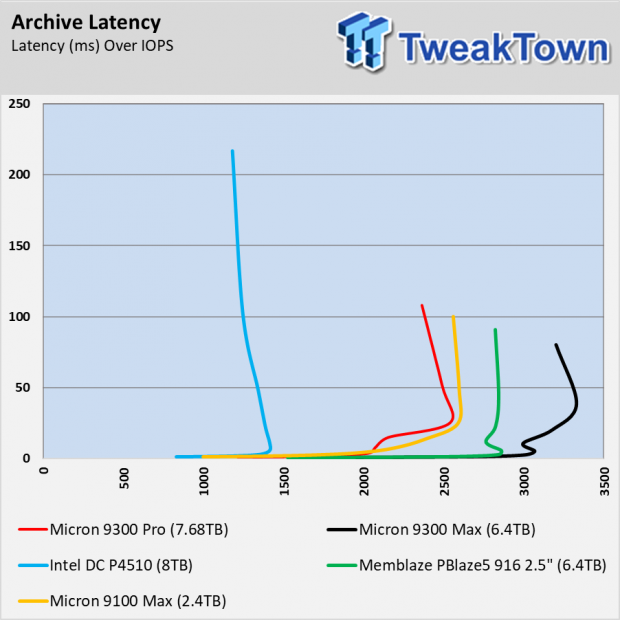
The archive test is one you might not be familiar with, it's certainly not published often. This test comes from Dell's performance lab and uses a mix of larger and small block sizes, as well as random and sequential data. The mix allows us to show an environment where you may have more than one workload running on a drive. The Micron 9300 Series allows for up to 32 NVMe namespaces so this is certainly within the bounds of what this product's capabilities.
We were surprised to see the Micron 9300 MAX outperform the similar Memblaze PBlaze5 916. This is likely due to superior firmware of the drives tested.
Final Thoughts
Micron tells us the 9300 Series is the most power-efficient and cost-efficient enterprise SSDs to date. The series is certainly impressive from a performance standpoint, but its larger capacity also reduces operating expenditure at the rack level.

It's been several generations since we've seen SSDs capable of delivering similar sequential reads and writes. With the transition to 3-bit per cell media this was thought to be a lost art without ample overprovisioning that shot costs beyond acceptable levels. Micron not only brought read and write performance in line, but also pegged the meter with 3,500 MB/s, near the top of what is possible with only four PCI Express 3.0 lanes.
With two distinct but closely tied products in the 9300 Series, administrators can use a single product family to cover several workloads. The different SKUs make the 9300 Series ideal for so many workloads we have to consider these as "general purpose" to some degree.
While many other companies offer different products for caching, AI/ML/DL training, HFT, and databases, the Micron 9300 Series bests the requirements of each category.
Of the enterprise SSDs, I've tested this year, it would be difficult to recommend anything other than the Micron 9300 Series for most use cases and workloads.
